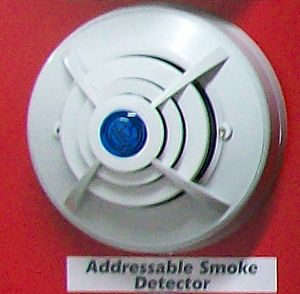Smoke detector facts for kids
A smoke sensor or smoke detector is a device that can detect smoke, which may be an indicator of a fire. There are two basic systems: Simple, standalone sensors usually make a sound or flash a light when they detect smoke. More sophisticated sensors usually send a signal to an fire alarm panel, or system. Most smoke detectors use either an optical sensor, or they use a physical process called ionization. Many simple smoke sensors use batteries. Very often dead batteries are not replaced; when this happens, the smoke sensors stop working. But, the detector may "chirp" when the battery is low to try and stop this from happening. There are also systems which are directly connected to electrical power; these may use batteries just as a backup.
Smoke detectors are housed in plastic enclosures, typically shaped like a disk about 150 millimetres (6 in) in diameter and 25 millimetres (1 in) thick, but shape and size vary. Smoke can be detected either optically (photoelectric) or by physical process (ionization); detectors may use either, or both, methods. Sensitive alarms can be used to detect, and thus deter, smoking in areas where it is banned. Smoke detectors in large commercial, industrial, and residential buildings are usually powered by a central fire alarm system, which is powered by the building power with a battery backup. Domestic smoke detectors range from individual battery-powered units, to several interlinked mains-powered units with battery backup; with these interlinked units, if any unit detects smoke, all trigger even if household power has gone out.
Contents
Design
Photoelectric
Photoelectric smoke detectors rely on detecting a lack of light to set the alarm off. The light used could be infrared, visible light, or ultraviolet. When smoke blocks out the light inside a photoelectric smoke detector, the smoke detector detects that there is less light. Below a certain brightness, whether or not it comes from smoke or not, the photoelectric smoke detector will beep.
Ionization
Ionization smoke detectors use radioactive elements to ionize the air. Alpha particles are released from the radioactive element onto air particles so that those air particles become charged. An ionization smoke detector will detect smoke if there is a change in voltage. If smoke enters the smoke detector, some of the alpha particles will attach to the smoke instead of the air particles. This will change the voltage inside the smoke detector, so the smoke detector will beep.
Ionization smoke detectors are cheaper than photoelectric smoke detectors, but they cause more false alarms than photoelectric smoke detectors. Additionally, ionization smoke detectors are slower to react in real house fires.
Images for kids
-
Inside a basic ionization smoke detector. The black, round structure at the right is the ionization chamber. The white, round structure at the upper left is the piezoelectric horn that produces the alarm sound.
See also
 In Spanish: Detector de humo para niños
In Spanish: Detector de humo para niños








